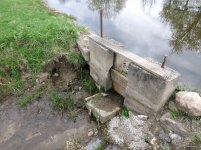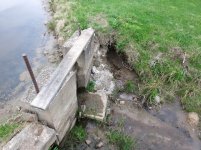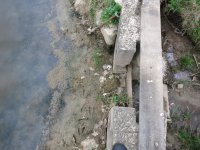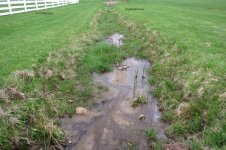aczlan
Good Morning
- Joined
- Mar 7, 2008
- Messages
- 17,540
- Tractor
- Kubota L3830GST, B7500HST, BX2660. Formerly: Case 480F LL, David Brown 880UE
We have an old concrete dam in a small pond on my inlaws farm which has a pretty good leak around both sides.
Here is the dam from the pond side:

And the outlet side:
Looking West:

Looking East:

And one more from the top:

If you look at the two pictures from the outlet side, you can see where the water has been going around the dam.
Last year, I stacked bagged concrete around the east side and it worked well for the summer, but its leaking again.
This is built on what the conservation office calls "sandy loam" not a lot of "watertight" soil around the pond.
Along with this project, we would like to fill in the ditch that leads from the pond to a culvert (probbaly ~200'). Given how things drain (the ditch is a low spot), the pipe will be 12" perforated double walled plastic pipe so that the existing water flow can continue. Here is a picture of the area where the pipe will be put in and backfilled:

One priority is that when all is said and done, there must not be any place for grandkids to slip, fall and end up stuck in the pipe.
So far, I have had two contractors come out to give me estimates and they have had two very different ways of fixing the problem.
Contractor A: Contractor A is highly recommended by the facilities people at work, he has done some work there and is turned out good. He does a lot of drainage for the farms and orchards in the area.
His suggestion is to bury a 60" tall catchbasin (like: Filtered Images (ParkUSA - Design for Water)) at a slight angle (leaning toward the pond so that the side toward the pond is 1" lower than the outlet side), so the low side of the top is level with the top of the current dam and make a small berm (6-10"?)around the other three sides so that when the pond rises, it flows into the grate and out via the pipe.
He would fill in around the box and the first 10-15' of the pipe with clay to make a "plug" that will keep the water out.
At 2-3 points along the perforated pipe, he would backfill it with washed stone all the way to the surface to provide a place for surface water to drain to.[/php]
Contractor B: Contractor B has done work for us in the past and does good work, but he is very busy and he uses us for fill in work, so he will start, do a piece, then disappear for 2-3 weeks (often leaving his equipment parked here, one time his Bobcat 335 mini excavator sat in our back field for the better part of a month).
He came out today (while I was at work, so I just spoke to him over then phone).
He proposes pouring a 16-18' wide dam, with a spillway much like the current dam, but with a slot sized to put 4x4s across to adjust water level, then having that feed into the pipe (he wasn't very clear over the phone how the transition to pipe will be handled and I didn't press as he said he will have a drawing for me tomorrow).
I asked Contractor B about Contractor A's plan and he said that its a bad idea as it "will just get pushed out in a year or two"
Personally, I really like Contractor A's plan as it seems to be the least complicated way to get water from point A to point B without having someplace where kids could get stuck when playing, but I am not an expert.
Looking to get some opinions from some knowledgeable parties who don't have a financial stake in the matter...
Thanks
Aaron Z
Here is the dam from the pond side:

And the outlet side:
Looking West:

Looking East:

And one more from the top:

If you look at the two pictures from the outlet side, you can see where the water has been going around the dam.
Last year, I stacked bagged concrete around the east side and it worked well for the summer, but its leaking again.
This is built on what the conservation office calls "sandy loam" not a lot of "watertight" soil around the pond.
Along with this project, we would like to fill in the ditch that leads from the pond to a culvert (probbaly ~200'). Given how things drain (the ditch is a low spot), the pipe will be 12" perforated double walled plastic pipe so that the existing water flow can continue. Here is a picture of the area where the pipe will be put in and backfilled:

One priority is that when all is said and done, there must not be any place for grandkids to slip, fall and end up stuck in the pipe.
So far, I have had two contractors come out to give me estimates and they have had two very different ways of fixing the problem.
Contractor A: Contractor A is highly recommended by the facilities people at work, he has done some work there and is turned out good. He does a lot of drainage for the farms and orchards in the area.
His suggestion is to bury a 60" tall catchbasin (like: Filtered Images (ParkUSA - Design for Water)) at a slight angle (leaning toward the pond so that the side toward the pond is 1" lower than the outlet side), so the low side of the top is level with the top of the current dam and make a small berm (6-10"?)around the other three sides so that when the pond rises, it flows into the grate and out via the pipe.
He would fill in around the box and the first 10-15' of the pipe with clay to make a "plug" that will keep the water out.
At 2-3 points along the perforated pipe, he would backfill it with washed stone all the way to the surface to provide a place for surface water to drain to.[/php]
Contractor B: Contractor B has done work for us in the past and does good work, but he is very busy and he uses us for fill in work, so he will start, do a piece, then disappear for 2-3 weeks (often leaving his equipment parked here, one time his Bobcat 335 mini excavator sat in our back field for the better part of a month).
He came out today (while I was at work, so I just spoke to him over then phone).
He proposes pouring a 16-18' wide dam, with a spillway much like the current dam, but with a slot sized to put 4x4s across to adjust water level, then having that feed into the pipe (he wasn't very clear over the phone how the transition to pipe will be handled and I didn't press as he said he will have a drawing for me tomorrow).
I asked Contractor B about Contractor A's plan and he said that its a bad idea as it "will just get pushed out in a year or two"
Personally, I really like Contractor A's plan as it seems to be the least complicated way to get water from point A to point B without having someplace where kids could get stuck when playing, but I am not an expert.
Looking to get some opinions from some knowledgeable parties who don't have a financial stake in the matter...
Thanks
Aaron Z
